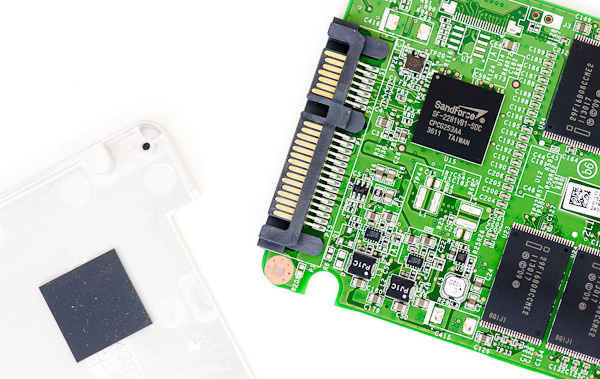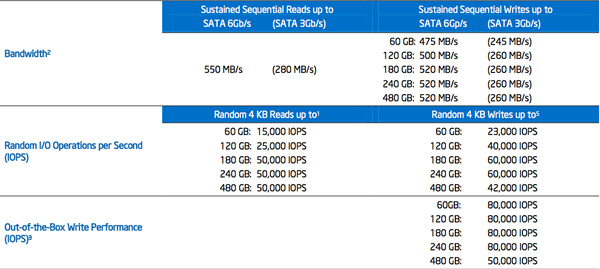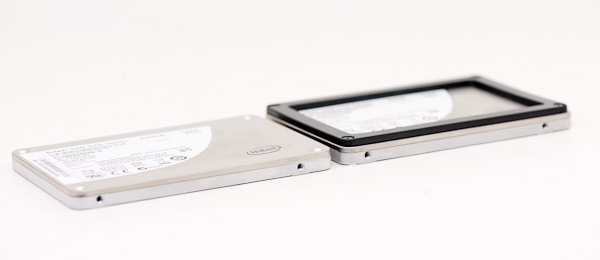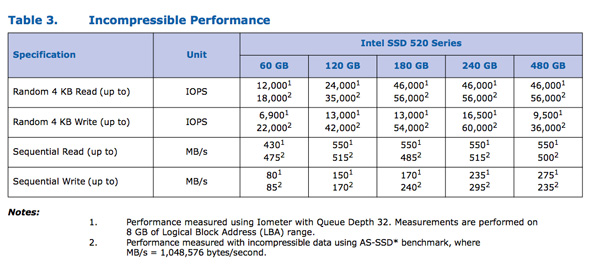Intel SSD 520 Review: Cherryville Brings Reliability to SandForce
by Anand Lal Shimpi on February 6, 2012 11:00 AM ESTThe Intel SSD 520
Intel sent us a 240GB and 60GB SSD 520 for review, but the performance specs of the entire family are in the table below:
The Intel SSD 520 is available in both 9.5mm and 7mm versions, with the exception of the 480GB flavor that only comes in a 9.5mm chassis. The 520's uses Intel's standard 7mm chassis with a 2.5mm removable plastic adapter that we've seen since the X25-M G2. The plastic adapter allows the drive to fit in bays designed for 9.5mm drives. Note that Intel doesn't ship shorter screws with the 9.5mm drives so you can't just remove the plastic adapter and re-use the existing screws if your system only accepts a 7mm drive.
Inside the drive we see the oh-so-familiar SandForce SF-2281 controller and Intel 25nm MLC NAND. The controller revision appears unchanged from other SF drives we've seen over the past year. The PCB design is unique to the 520, making it and the custom Intel firmware the two noticeable differences between this and other SF-2281 drives.

Intel uses the metal drive chassis as a heatsink for the SF-2281 controller
The SF-2281 Controller
I've explained how the SF-2281 works in the past, but for those of you who aren't familiar with the technology I'll provide a quick recap. Tracking the location of data written to an SSD ends up being one of the most difficult things a controller has to do. There are a number of requirements that must be met. Data can't be written to the same NAND cells too frequently and it should be spread out across as many different NAND die as possible (to improve performance). For large sequential transfers, meeting these (and other) requirements isn't difficult. Problems arise when you've got short bursts of random data that can't be combined. The end result is leaving the drive in a highly fragmented state that is suboptimal for achieving good performance.
You can get around the issue of tracking tons of data by simply not allowing small groups of data to be written. Track data at the block level, always requiring large writes, and your controller has a much easier job. Unfortunately block mapping results in very poor small file random write performance as we've seen in earlier architectures so this approach isn't very useful for anything outside of CF/SD cards for use in cameras.
A controller can rise to the challenge by having large amounts of cache (on-die and externally) to help deal with managing huge NAND mapping tables. Combine tons of fast storage with a fast controller and intelligent firmware and you've got a good chance of building a high performance SSD.

SandForce's solution leverages the work smart not hard philosophy. SF controllers reduce the amount of data that has to be tracked on NAND by compressing any data the host asks to write to the drive. From the host's perspective, the drive wrote everything that was asked of it, but from the SSD's perspective only the simplest representation of the data is stored on the drive. Running real-time compression/de-duplication algorithms in hardware isn't very difficult and the result is great performance for a majority of workloads (you can't really write faster than a controller that doesn't actually write all of the data to NAND). The only limit to SandForce's technology is that any data that can't be compressed (highly random bits or data that's already compressed) isn't written nearly as quickly.
Intel does a great job of spelling out the differences in performance depending on the type of data you write to the SSD 520, but it's something that customers of previous Intel SSDs haven't had to worry about. Most client users stand to benefit from SandForce's technology and it's actually very exciting for a lot of enterprise workloads as well, but you do need to pay attention to what you're going to be doing with the drive before deciding on it.
The Intel SSD Toolbox
The Intel SSD 520 works flawlessly with the latest version of Intel's SSD Toolbox. The toolbox allows you to secure erase the drive from within Windows, and it also allows you to perform firmware updates and pull SMART info from the drive. Unlike other SandForce toolboxes, Intel's software works fine with Intel's RST drivers installed.

The Test
| CPU | Intel Core i7 2600K running at 3.4GHz (Turbo & EIST Disabled) - for AT SB 2011, AS SSD & ATTO |
| Motherboard: | Intel DH67BL Motherboard |
| Chipset: | Intel H67 |
| Chipset Drivers: | Intel 9.1.1.1015 + Intel RST 10.2 |
| Memory: | Corsair Vengeance DDR3-1333 2 x 2GB (7-7-7-20) |
| Video Card: | eVGA GeForce GTX 285 |
| Video Drivers: | NVIDIA ForceWare 190.38 64-bit |
| Desktop Resolution: | 1920 x 1200 |
| OS: | Windows 7 x64 |























138 Comments
View All Comments
frank1985 - Monday, February 13, 2012 - link
I am a customer of this guy, and I had to return my $240 Corsair Force 2 drive/paperweight *11 days* after purchase (at which point I traded it in for his old OCZ Vertex2 which has been running without issue).Like Iketh, the fact that you can't recover performance with TRIM is a showstopper for me. I'm going to stick with the 320 series drives - they might be slower, but TRIM does what it's supposed to.
Wolfpup - Monday, July 23, 2012 - link
The TRIM issue worries me too. Sounds like it's even worse than on Micron/Crucial's M4?My 320's been great, though annoyingly the 600GB version is MASSIVELY more than the 480GB 520, or the 512GB M4...possibly because of this issue?
Ratman6161 - Wednesday, February 8, 2012 - link
I have an OCZ drive based on the SF22xx. For the first month it was nothing but trouble. Then with the release of the 2.15 firmware, suddenly all the problems went away like magic. It could simply be that OCZ paid the price for being early adopters and released to the market a product that really should have been a Beta version. Now that it has the firmware that it should have had from the beginning, everything is fine.Intel has waited until the product is more mature so its no surprise they aren't seeing these problems
Wolfpup - Monday, July 23, 2012 - link
Did you read the article? Intel explicitly fixed problems still present in other firmware.ckryan - Tuesday, February 7, 2012 - link
The Samsung 830 is maybe the finest consumer drive released in all of 2011. There is no shame in going Samsung, and in my mind, it's a fine alternative to almost every drive out there.Samsung and Micron probably have to wonder how Intel gets all the press about their NAND being better. As far as I can tell, Samsung's 27nm Toggle in the 830 is pretty damn good. The Micron NAND used in Micron's own drives is fantastic, and of course Intel's top shelf NAND is good too. But only Intel gets the press for having excellent NAND in it's own drives.
I don't think enough emphasis is placed on the NAND. You can't get a clear picture of NAND quality through benchmarking.
krumme - Monday, February 6, 2012 - link
Exit Intel from the controller market. No wrapping in reliability, as rightfully as it is, can change that fact seen from here.Anyway, Intel can earn on the memory, as was probably the plan from day 1. We will see how profitability is here in 5 years time.
tipoo - Monday, February 6, 2012 - link
I still get a kick out of how a relatively tiny startup company makes better performing parts than the chipzilla that is Intel. Good call working with them.Makaveli - Monday, February 6, 2012 - link
What I think you are missing is that Intel doesn't because they don't have to or care to. Intel is a huge company with equally big profit margins to maintain for their shareholders. The SSD market is still a small compared to the other things they dabble in. And yes they produced a controller in the past but I don't think the Money and R&D was worth it for them to continue based on the profits needed to keep them interested. We already know they make a ton of money selling nand as is.So to sum it up they could easily put out a controller that would be superior but just don't care too at the moment.
Kevin G - Monday, February 6, 2012 - link
Intel's plan was to gain control of the entire SSD product: from flash (joint venture with Micron), to the controller and to the firmware. It does appear that their original plan has fallen apart due to delays with their custom controllers which has forced them to use 3rd party controllers.I wouldn't say that Intel has stopped investing into developing their own controllers though. Intel can offer a level of integration that no other vendor can offer: direction integration into an x86 SoC. I strongly suspect that the successor to Haskwell and future Atom SoC will come with a direct ONFI connectivity backed by an internal Intel controller.
At that point in time, I suspect that SSD controllers will become akin to what discrete GPU's are today: a midrange or high end item for consumers.
NitroWare - Wednesday, February 8, 2012 - link
People forget Intel was one of the innovators in bringing MATURE Flash to consumer technologies.Intel Desktop and OEM motherboards have used their surface mount flash chips for PC BIOS since 1996. This setup provided a recovery mode to get out of BIOS corruption. To this day, excluding motherboards with dual BIOS no motherboard has the same robust recovery system as Intel boards do.
If the recovery mechanism fails then there is a more serous failure anyway.
At the time other vendors were still using older DIP socket EEPROM and some still do now , only changing to serial format ROM.
Even for current ASUS Flagship ROG boards, the best failsafe they offer is a socketed BIOS.
Intel offered those Turbo Boost Flash cards several years ago for the 1156 motherboards and laptops which did not take off. They also championed Hybrid HDD for portables.
So I think Intel know what they are doing with solid state, but yes eventually the technology will become commodity